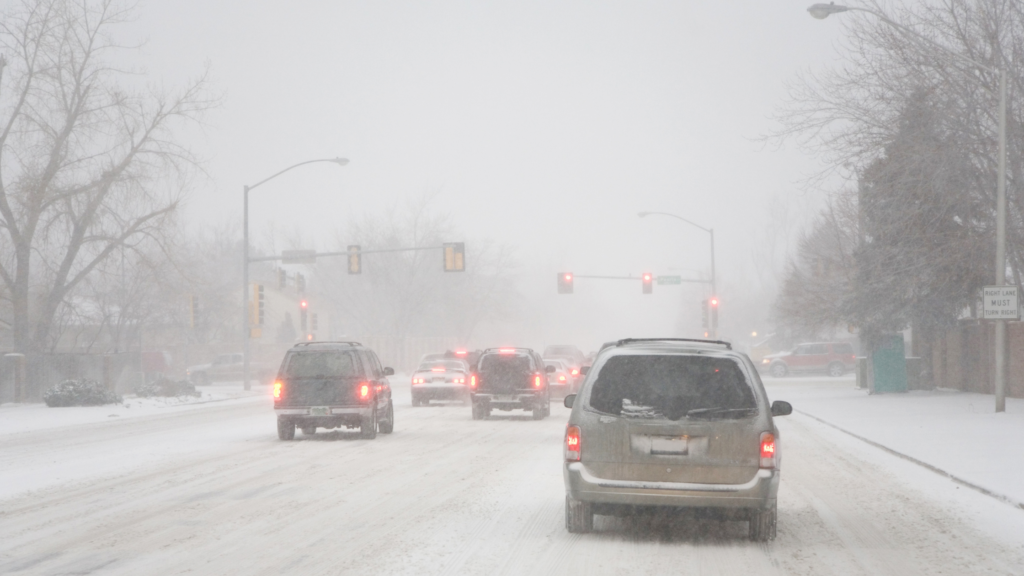- News
- America’s Worst State for Winter Accidents: It’s Pure Michigan
America’s Worst State for Winter Accidents: It’s Pure Michigan

Fellow Michiganders, we’ve just won another distinguished honor. You may recall that in 2018 we came in as the sixth most-likely state for drivers to get in a snow-related auto accident. And in 2020 (that first pandemic year we all want to forget) you may not be surprised to learn that we earned the coveted title of most dangerous state of all for winter driving! That’s right — we even beat Alaska, of all places (which, to its unfortunate credit, finished a strong #2 for winter driving danger)! Congrats to the whole team.
How did it happen? According to MoneyGeek.com which put together the 2020 statistics, Michigan actually finished in the top spot among all the states for winter driving fatalities… over the past three years! Furthermore, we also had a disproportionately high fatality rate even when the data was adjusted for actual miles traveled. Ironically, we “won” this morbid distinction despite being hailed as one of the top 10 states for safe drivers (although that praise may be skewed thanks to Michigan’s no-fault insurance law which can muddy poor driving statistics).
But last year’s horrible winter driving fatality numbers aren’t the only bad news for Michigan drivers. For the five-year span from 2013-2017, we were also the most dangerous state of all, with the greatest number of winter fatalities anywhere in America. For context, Michigan topped runner-up Pennsylvania’s winter traffic deaths by more than 40 percent over that period!
There are several good reasons for Michigan’s poor showing when it comes to winter driving statistics. For one thing, the west side of the state is plagued with lake effect snow — those massive drifts that accumulate when frigid air crosses Lake Michigan and generates snow squalls that spew snowflakes on the state’s eastern shore. Not to mention that traffic doesn’t slow down in the winter months, which will be especially true this year with most pandemic restrictions no longer in place despite a recent rise in Michigan’s COVID-19 cases. And, of course, there’s that slick highway hazard we fondly refer to as black ice, the thin, deadly glazing that’s nearly invisible on highways crisscrossing the state. (You may want to browse this guide from the U.S. Forest Service explaining how to drive more safely in black ice conditions.)
What Are the Most Dangerous Roads and Places in Michigan for Winter Traffic?
As you may suspect, the deadliest Michigan roads for wintertime crashes are our usual suspects: I-94, I-75, and I-96, each of which recorded double figures for accident fatalities according to a report published by ValuePenguin.com. Among our cities, Detroit was far and away the jurisdiction with the most winter traffic deaths, perhaps because all three of those dangerous interstate highways cross into the city limits. Other hot spots cited for significant wintertime traffic fatalities were Pontiac, Romulus, and Lansing.
What are the Most Dangerous Months for Michigan Drivers?
Winter is undeniably a treacherous time to be on the road, but if you’re thinking the snowiest months are the most dangerous, think again. The month with the highest number of statewide traffic accidents last year was October which accounted for 26,276 motor vehicle accidents. The next most accidents occurred in February with 25,946, January with 25,822, November with 24,475, and December with 21,651. If you think you’re seeing a pattern here, that’s because you are. The colder, darker, fall and winter months are consistently the riskiest times to be on the road in Michigan. In contrast, the safest month statewide in 2020 was April, with just 8,748 crashes reported. (To be fair, that was at the very beginning of strict COVID-19 lockdowns, which likely depressed the number of accidents.)
To Stay Clear of the Law This Winter, Clear Your Windshield.
We’ve discussed Mother Nature’s ill effects on Michigan roadways in the wintertime, but human factors also play into our poor showing for winter driving safety. How many times have you seen your fellow drivers squinting through frost-covered windshields as they attempt to leave their driveways in hopes their defrosters will soon kick in? You’ve probably also noticed cars and trucks shedding layers of powdery snow as they speed down the highway, impeding the vision of anyone unfortunate enough to be following them. Yes, it can be cold and unpleasant to sweep piles of fresh snow off your car’s roof, but if you don’t clear your car, you’re a creating genuinely blizzard-like conditions for anyone traveling behind you.
This is not only discourteous, it’s also illegal. Did you know that driving a snow-covered car is against the law in Michigan and numerous other states? That’s because around 70 years ago, the state legislature decided to make it illegal to deposit snow, ice or slush on any road surface. (Mother Nature is exempt from that statute, at least for now.)
What’s more, driving your car with anything (such as frost) on your windshield that obstructs your vision is also a criminal offense. So, it pays to scrape thoroughly — if you want to avoid a brush with the law.
An article published in the Detroit Free Press sums it up for us: “You can be cited for a vision obstruction if you don’t clear the snow and ice from your car. You can also get a citation for depositing snow on the road from the top of your vehicle. Both are civil infractions,” according to a Michigan State Police official interviewed by the publication.
How Can You Be Safer During Winter Travel?
One of the primary ways to remain safer on the wintry roads is to simply practice common sense. For instance, it goes without saying that obeying the speed limit is always a good idea — even more so when snow and ice are covering the roads. As is keeping your windshield washer reservoir filled with antifreeze solvent during the winter months.
But other strategies may be less obvious. Winter comes with its own set of hazards, one of which is hypothermia. Forest rangers, ice road truckers, and others who work outdoors in bitter climates know that if you find yourself trapped in a vehicle after sliding off an icy road, a vehicle blizzard safety kit can save your life. The U.S. Forest Service also offers a handy guide listing several key items to include in your safety kit, such as a coffee can (to hold recommended materials), candles, matches, snacks, water bottles, pain relievers, and related survival supplies.
But spinning off a slick road isn’t the only danger to be wary of over the coming few months. If the worst happens, and you find yourself involved in an accident during a winter storm, remember to remain with your vehicle (if safe to do so), call law enforcement authorities for help, and — once you’re safely home — contact the personal injury attorneys at Mike Morse Injury Law Firm. In a recent blog post, we detailed key steps to take if you’ve been in an accident that may be beneficial should you find yourself in such unfortunate circumstances. And one of the most important of those steps is giving us a call at 855-MIKE-WINS (855-645-3946). You can also contact us via text message at 833-898-MIKE (833-898-6453), or online, 24/7. But hopefully you’ll have several months of incident-free driving… which could go a long way toward helping Michigan rank better for safe winter driving in next year’s report!

Content checked by Mike Morse, personal injury attorney with Mike Morse Injury Law Firm. Mike Morse is the founder of Mike Morse Law Firm, the largest personal injury law firm in Michigan. Since being founded in 1995, Mike Morse Law Firm has grown to over 200 employees, served 40,000 clients, and collected more than $1.5 billion for victims of auto, truck and motorcycle accidents. The main office is in Southfield, MI but you can also find us in Detroit, Sterling Heights and many other locations.








